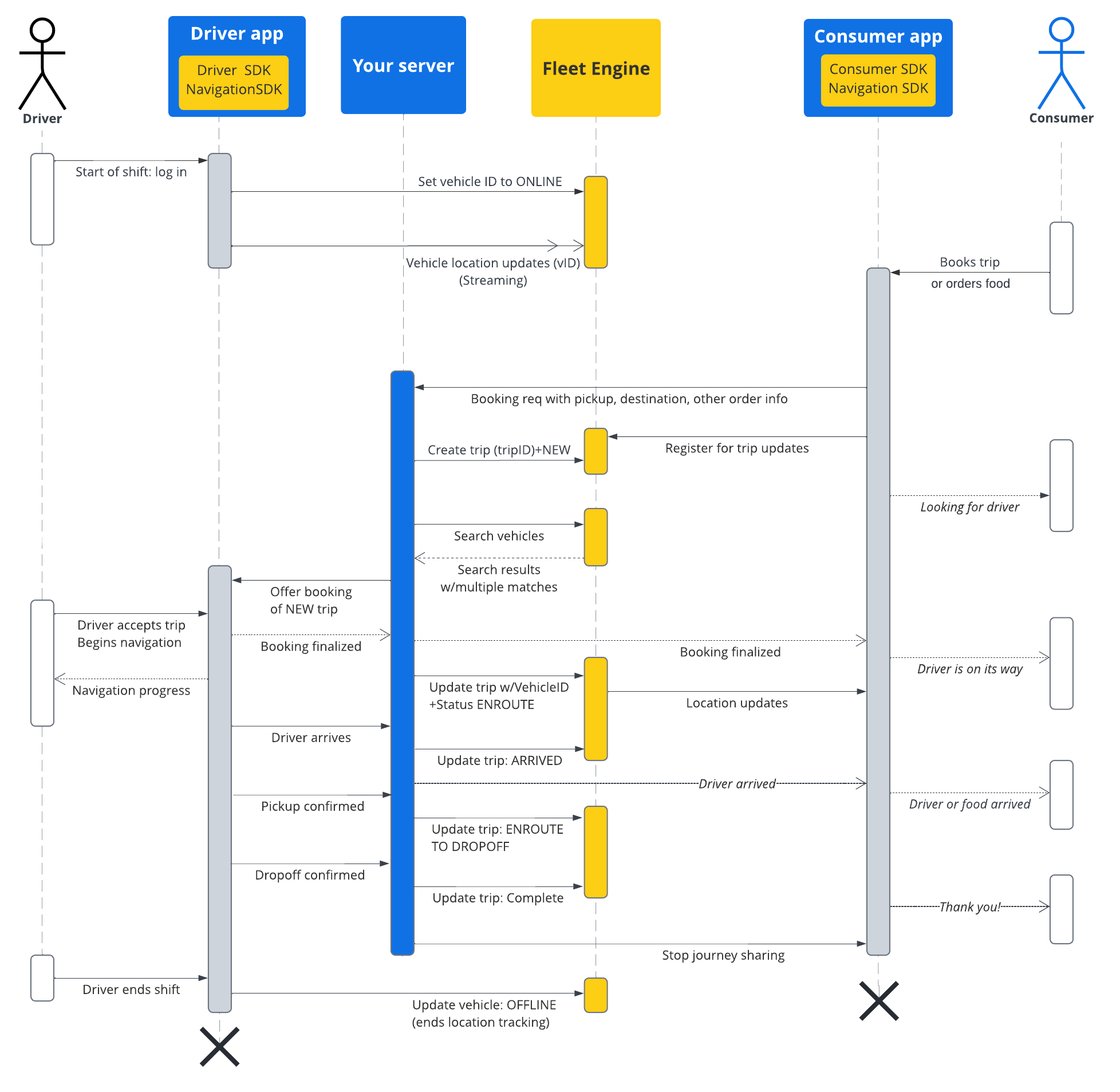Bu bölümdeki belgelerde, Google Haritalar Mobility on-demand geziler hizmetini kullanarak gezileri nasıl oluşturacağınız ve bunlarla nasıl çalışacağınız gösterilmektedir. Aşağıdaki konular hakkında bilgi sahibi olduğunuz varsayılır:
- Fleet Engine: Fleet Engine'in uygulanmasıyla ilgili ayrıntılar, istek mekanizmaları ve güvenlik hakkında bilgi sahibi olmanız gerekir. Bu konuda bilgi edinmek için Fleet Engine hizmeti nedir? başlıklı makaleyi ve Fleet Engine'i ayarlama bölümündeki güvenlik konularını inceleyin.
- İsteğe bağlı hizmetler için araçlarla ilgili temel bilgiler. Araçlara giriş başlıklı makaleyi inceleyin.
- İsteğe bağlı hizmetler için seyahatle ilgili temel bilgiler. Talep üzerine yolculuklar başlıklı makaleyi inceleyin.
Kullanacağınız TripService, gRPC ve REST için kullanılabilir.
Kolaylık sağlamak için alan referansları gRPC kuralına uygundur.
Talep üzerine hizmetler için Fleet Engine'de yolculuk, tüketicilerinizden gelen yemek teslimatı veya yolculuk isteğinin karşılanmasını modelleyen bir tür seyahattir. Bir yolculuğun, yolculuk ilerledikçe Fleet Engine'e bildirdiğiniz bir durumu vardır. Örneğin, NEW, ENROUTE_TO_PICKUP ve daha fazlası. Seyahat durumu, araca atanan coğrafi konumlu yol noktalarına karşılık gelir ve Fleet Engine, yaptığınız her seyahat güncellemesiyle bu araç yol noktalarını değiştirir. Geziler ve araçlarla ilişkileri hakkında daha fazla bilgi için Fleet
Engine Essentials'daki İsteğe bağlı geziler bölümüne bakın.
Seyahatin ömrü
Fleet Engine'deki her yolculuğu izlemek için öncelikle bir Trip
oluşturmanız gerekir. Referans için gRPC veya REST'e bakın.
Aşağıdaki tabloda, sisteminizde oluşturulan bir seyahatin uçtan uca akışına ve Fleet Engine'deki yaşam döngüsü aşamalarına dair bir örnek açıklanmaktadır. Fleet Engine'i ayarladığınız ve sürücü uygulamasında konum güncellemeleri etkinleştirilmiş olarak geziye atayacağınız bir aracınız olduğu varsayılır. Driver SDK: Talep üzerine geziler başlıklı makaleyi inceleyin.
| 1 | Rezervasyon isteği alma | Bir Fleet Engine yolculuğu başlamadan önce, rezervasyon sisteminiz ilk olarak uygulamanız veya başka bir rezervasyon sistemi aracılığıyla tüketiciden yolculuk ya da teslimat isteği alır. Sisteminiz daha sonra CreateTrip kullanarak, teslim alma konumu gibi gerekli alanları kullanarak gezi varlığını oluşturur.
Bu noktada yolcular ve bırakma yeri gibi diğer alanları da ayarlayabilir veya bir araç atayıncaya kadar bekleyebilir. Tek varış noktalı bir gezi oluşturma konusuna bakın. |
| 2 | Araç atayın. | Araçları doğrudan sisteminiz üzerinden yolculuklara atayabilir ve atamayı Fleet Engine'e bildirebilirsiniz veya Araç Ara hizmetini kullanarak yolculuk ve araç özelliklerine göre filtreleme yaparak yolculuğu tamamlamak için en iyi aracı bulabilirsiniz. Arama yarıçapınızdaki herhangi bir çevrimiçi araç, Sürücü SDK'sı tarafından sağlanan konum güncellemeleri aracılığıyla yakınlığını bildirir.
|
| 3 | Seyahati güncelleyin. | Sürücü yolculuğu kabul edip yolcuyu alma konumuna gitmeye başladığında sisteminiz yolculuk durumunu NEW'dan ENROUTE_TO_PICKUP'ye günceller. Uygulamadan arka uçunuza doğrudan bağlantı kurarak veya Driver SDK'sından sürekli olarak araç konumu güncellemeleri alan Fleet Engine'i yoklayarak yolculuk boyunca araç konumunu yoklamaya devam edersiniz. Sisteminiz daha sonra her yolculuk kilometre taşını Fleet Engine'e bildirir ve Fleet Engine de aracın rota noktası listesini buna göre günceller.
|
| 4 | Tüketiciyle yolculuğu paylaşın. | Fleet Engine, gezi ayrıntılarını ve araç konumunu Consumer SDK'da kullanılabilir hale getirir. Consumer SDK, gezi güncellemelerini almak ve bunları tüketici uygulamasında göstermek için bir dinleyici kullanır. Fleet Engine, tahmini varış zamanını, kalan mesafeyi, rotaları ve kalan araç yol noktalarını otomatik olarak günceller. Daha fazla bilgi için İsteğe bağlı seyahatler için yolculukları paylaşma bölümüne bakın. |
| 5 | Tam gezi. | Araç yolculuğun hedef noktasına ulaştığında ve sürücünüz yolculuğun başarılı olduğunu belirttiğinde, sisteminiz Fleet Engine'de TripStatus değerini COMPLETE olarak ayarlar. Araçlar gibi, seyahat varlıklarının da durumlarına bakılmaksızın Fleet Engine'de 7 gün boyunca aktif kaldığını ve bu noktada kaldırılacağını unutmayın. |
Seyahat sırası akışı
Aşağıdaki diyagram bu akışın daha detaylı bir görünümünü göstermektedir.


